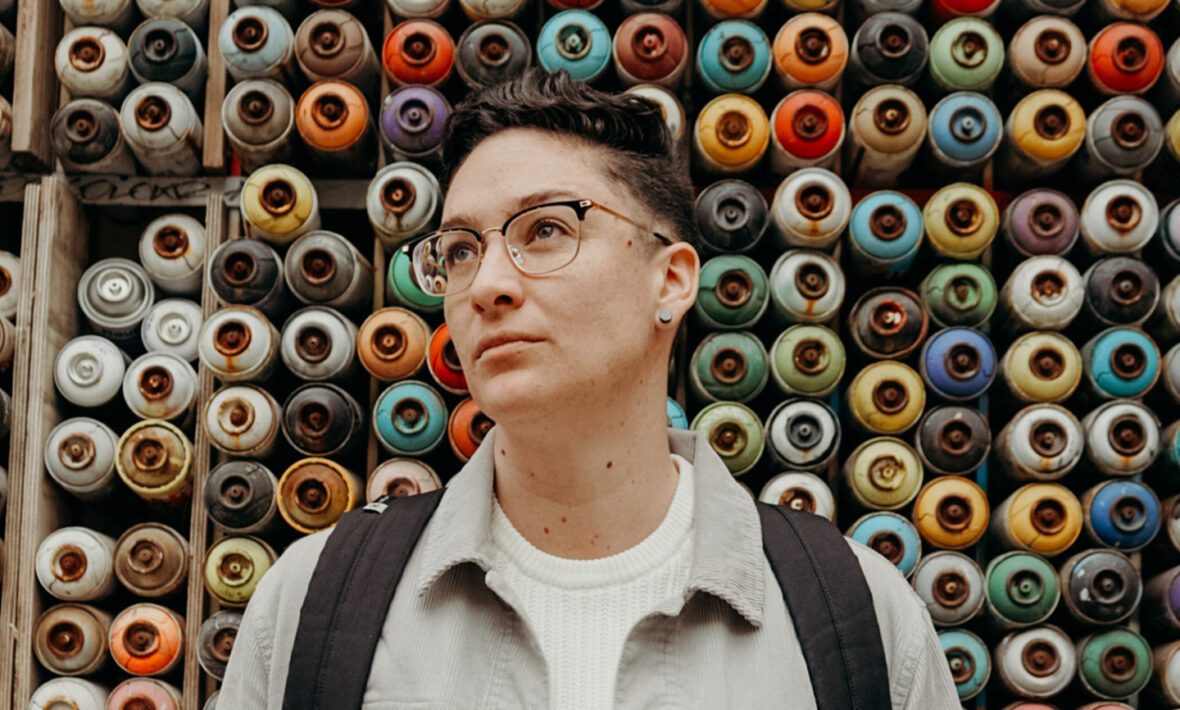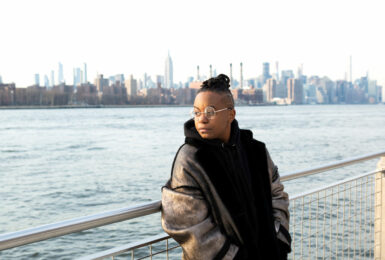
I’ve been mistaken for a man on five continents.
Sometimes it’s an innocent confusion, like when the cashier in London didn’t look at my face while ringing up my order and asked, “will that be all, sir?”
Sometimes, it’s comical like in Korea, when a tiny elderly grandma chased me with a mop for using the women’s bathroom.
And sometimes, it’s terrifying like in Baltimore, when a homeless man followed my wife and I down a dark road while yelling “are you a fag or a dyke?”
I get it. I’m 6 foot tall, have short hair, and wear men’s clothing. How I will be perceived varies widely depending on where I am, the awareness of LGBT people in the area, and their familiarity with Caucasian faces.
Normally when we travel, I stand out like a sore thumb. It sounds bad – but it’s just my reality.
I’m usually the tallest person in the room in Mexico. In the US, people stare or make snarky comments. In some countries, I’m constantly playing the guessing game of which gender do people think I am today? Traveling while androgynous can be a whirlwind adventure.
I’ve held my wife’s hand on flights where she was terrified I’d be arrested for being queer in the immigration line. I’ve needed my sister to guard the bathroom door in places where I’m afraid to use the facilities. I’ve even witnessed my loved ones verbally berate people for their nasty comments and stares in multiple counties.
As a gender non-conforming person, I need these allies in my life.
It’s not just about the stares I receive or being uncomfortable – it’s about safety.
Being LGBT is still illegal in 70+ countries. One in four transgender people has experienced physical assault because of their gender identity. Combine the two together and you’re in for a wide variety of horrifying stories.
I’ve experienced some of the most affirming and validating spaces in my life as a traveler but also some experiences that have shaken me to my core.
Like in Sweden, where I experienced a country that was designed with people like me in mind. It was a breath of fresh air to know that it was possible to put policies in place that not only tolerated people like me but accepted and celebrated people like me. I could physically feel myself relax when I realized I didn’t have to plan my entire day around using the bathroom because there are gender-neutral washrooms in every public space. I was able to eat and drink normally without having to think about whether having one too many glasses of water would put me in a position where using the bathroom was a safety concern and I needed to question if getting beaten up by some father for using the women’s restroom with his daughter was the best option. Or if using the men’s room and risking sexual assault was the better choice that day.
In Sweden, it wasn’t only bathrooms – it was clothing stores where the garments were labeled by size rather than gender and Pride celebrations where businesses had to be told to fly the rainbow flag – not because they weren’t supportive but because the idea of being homophobic towards customers was so out of the realm of possibility that they hadn’t even considered needing a physical symbol of acceptance.
But I’ve also experienced the other end of the spectrum, like when we boarded our flight to Egypt for our Nile Adventure with Contiki just days after 50 people were arrested for flying the rainbow flag at a concert. I’ve never been more afraid in my life than I was in that moment.
Or during my time in Istanbul, when I had a chance to visit some of the most beautiful mosques in the world. The ornate tile work, stunning stained glass, and beautiful marble carvings were some of what drew me to Istanbul in the first place. There was however one decision that kept gnawing at me, would I cover my hair or not? I was deeply aware of two major factors in this decision. One being, women are asked to dress modestly and cover their hair upon entering a mosque. Two, my gender presentation was being read as 100% male by the Turkish people.
Ultimately, I made the decision to leave my hair uncovered because I felt like that was safest for me. My concern was that adding a scarf drew attention to my gender and away from the purpose of the sacred place we were visiting. In my experience, that debate and the uncertainty is what makes people uncomfortable at best and violent at worst. The reality is my gender presentation impacts nearly every one of my social interactions while traveling. I try, more often than not, to make the choice that is most culturally appropriate for the place I am visiting, but at times I have to put my own safety first.
On that same trip, I psyched myself out about visiting a Hamam in Turkey and ended up bailing on my appointment. I try my hardest not to let my fear of gendered spaces, especially in situations where I don’t speak the language, dictate my experiences. But sometimes it gets the best of me. I had been in Turkey for 24 hours and knew that I was completely male passing…but obviously that wouldn’t be possible when I’m naked in a spa. I’m determined to have the experience the next time I visit Turkey but am going to take a little more time to figure out exactly how best to do it in a way that’s safe and comfortable for me.
For me, travel is a constant stream of small decisions of how to stay safe, how to stay true to myself and to respect the culture I’m immersed in. But sometimes, the fear gets the best of me and I miss out on opportunities because I choose to opt out of risk.
I do want to be clear about something. My story is not the same as everyone else’s story. The experiences of a gender nonconforming, non-binary, and trans traveler vary widely depending on multiple factors. I hate to admit it, but sometimes when I pass as a man, I have an easier time traveling with my wife. But there are many people like me who will never pass as one gender or the other regardless of the effort they put into it. Our experiences also vary based on the levels of privilege we carry into an experience. How I’m treated will be very different than how a black trans woman may be treated. I can’t be the spokesperson for all people who ever lived that color outside the gender lines. We’re a diverse and nuanced community and each one of us experiences the world in unique ways.
But I can use my platform as a travel blogger to reach out to you, dear readers, and ask you for help with supporting the people like me that you may have in your life. You can start by accepting that some times gender is confusing and messy and has a lot of grey area. And by understanding that someone’s gender identity and how they choose to dress is not about you, but about them. You should also know that when one non-binary person or gender nonconforming person says something is okay for them, that doesn’t necessarily mean it’s okay for everyone in the community. A good example is using multiple pronouns, some people are okay with using he, she, and they for themselves – others are not. It’s a person by person conversation.
As children, we’re taught that gendered rules are polite, like men opening doors, pulling out chairs, and accepting the check.
Or using “sir” and “ma’am” or “ladies and gentlemen” are respectful and a way of showing hospitality. But actually, these words and actions can misgender and hurt people all the time. You can stop using gendered language and actions and still be polite. Let your gender nonconforming loved ones know that you support them, without expectation and regardless of what they are wearing that day. If you see someone whose gender expression confuses you in a bathroom, locker room, or other gendered space, don’t stare. Be friendly and just mind your own business. But in the same regard, call attention to places that have single stall bathrooms for your loved ones and point out when they have a binary-gendered label on them. The single stall bathroom in your home is all-gender, all bathrooms should be too. Volunteer to go with someone if they’re nervous in a space, like while shopping for clothing or in situations involving swimsuits. But most of all, be a vocal advocate. Share your resources with other cis folks. Become an advocate and a teacher. Don’t be afraid to start the conversation.




